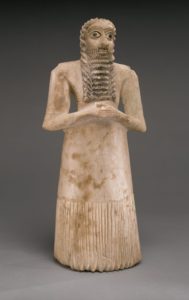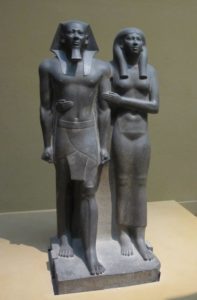The past few months we have examined different art works and their relevant history in Ancient civilization such as Mesopotamia, Egypt, Greek, and Roman. All of these civilizations had many things in common, but also many differences.
For example, both Ancient Mesopotamia and Ancient Egyptian art shared the value of Gods. The Gods were the main focus of art for these civilizations, but were expressed in different ways and had visible physical differences. In Ancient Mesopotamia, the Gods were worshipped extensively as a way to avoid bad fortune. This civilization believed that if bad things were to happen to the community, for example bad crops, then this was because they were not pleasing the Gods enough. Statuettes were made, such as the Standing Male Worshipper, as a way to show the Gods that even though they were working or doing other everyday activities, they were still worshipping and praying to the Gods. When looking at this statue, some “identifiers” of Mesopotamian art are big eyes, long hair organized in a uniform manner, and hands folded in prayer. In Ancient Egypt, the Gods were worshipped as well and played a huge part in the civilizations narrative, but we begin to see more sculptures and artwork regarding Pharaohs, who were considered to be the mediators between the Gods and the people. When looking at Ancient Egyptian art, specifically Menakure and Queen we begin to see some differences. For example, although the similarity is that both sculptures are clothed, one important thing to note is the fact that the Pharaohs feet do not touch the ground, this was to signify that he was above the people and closer to the Gods in social class. This sculpture is also more polished.


Moving on to Greek and Roman art, there are many similarities that arise then there is a shift to new differences as new eras arise. During Greek and Roman Art, there began to be a new emphasis on Humanism, which is focusing and emphasizing on the human as the main object of the world instead of the Gods. In addition to that, Humanism focuses on the human beliefs, values, and individuality. Humanism can be seen in Discobolus, in which the physical human body is clearly emphasized. In strong contrast to the previous artworks that were mentioned, this sculpture portrays the naked human body. The Greeks saw the human body as something to take pride in and to value, and instead of using headpieces and other things to signify power, they allowed the human body to signify power and strength. Lastly, we delved in to the history of the Roman Republic which once again showed a change in the expression of artwork. The Roman Republic still fixated on humanism, but now emphasized verism which means truth-telling. Verism was used to show the Roman Republic’s value of age, wisdom, and real human emotion/personality traits. For example, looking at this sculpture, we see that this man does not have a polished face to show youth, which can be seen in previous Greek and Roman art, instead we see effort to make the man’s face have very noticeable wrinkles. The Roman’s wanted to display age because it was now deeply valued and age meant that someone had a lot of wisdom to give. In this sculpture, we also see emotion, but not dramatic emotion. In this era emotions displayed in the artworks were more realistic and in-tune with a person’s own personality traits. In this sculpture, we could simply say that man just seems ill-tempered or grumpy.



